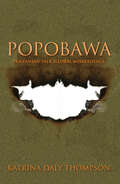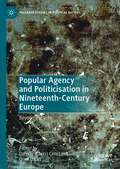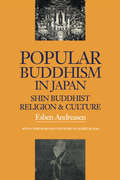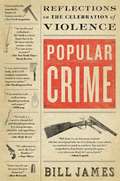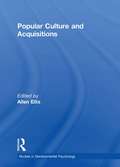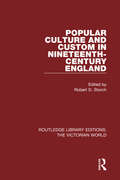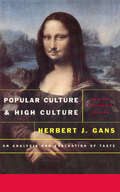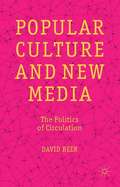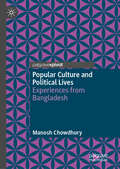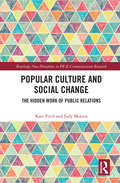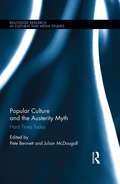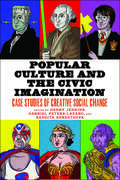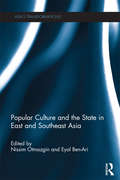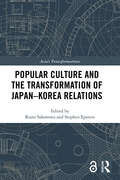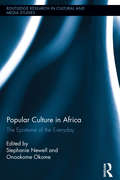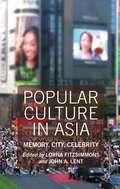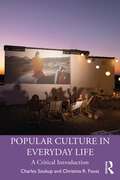- Table View
- List View
Popmix, POPkultur und Religion: Neue Streifzüge durch erweiterte Galaxien (pop.religion: lebensstil – kultur – theologie)
by Julian Sengelmann Stephanie Lerke Simon Luthe Jan Christian PinschDieses Buch versammelt vielfältige Beiträge zum Verständnis gegenwärtiger Kultur(en), zur Gestaltung (pop-)kultureller Religionspraxis und zur Konturierung einer (POP-)Theologie des 21. Jahrhunderts. Entstanden sind sie anlässlich der gleichnamigen Jahrestagung der Theologischen Gesellschaft für POP-, Kultur- und Religionserforschung (pop.religion) im Frühjahr 2022. „Neue Streifzüge durch erweiterte Galaxien“: Im Untertitel klingt bereits an, dass das Buch Zugänge in ein breites thematisches Feld eröffnet. So finden sich theologische und kulturtheoretische Betrachtungen zu den Galaxien „Film und Fernsehen“, „Literatur und Kunst“, „Musik und Subkultur“ sowie „Technologie und Digitalisierung“. Die thematische Vielfalt der „Next Generation“ spiegelt sich in diesen Beiträgen eindrucksvoll wider. „James Bond“ rückt etwa genauso in den Fokus wie „Germany’s Next Topmodel“. Die faschistoide Bildsprache in der Popkultur „Zwischen Riefenstahl und Rammstein“ steht neben der poimenischen Dimension von Souvenirs und Andenken. Eine Systematisierung von Hip Hop und Religion wird ebenso diskutiert wie die „Autonomie der Kirchenmusik“, und dazwischen geht es um die drängende Frage nach Antisemitismus und wiedererstarkenden Verschwörungserzählungen im popkulturellen Mainstream. Auch Beiträge der digitalen Tagung „Künstliche Intelligenz – Interdisziplinäre Perspektiven im popkulturellen Horizont“ bereichern den Sammelband.
Popobawa: Tanzanian Talk, Global Misreadings
by Katrina Daly ThompsonSince the 1960s, people on the islands off the coast of Tanzania have talked about being attacked by a mysterious creature called Popobawa, a shapeshifter often described as having an enormous penis. Popobawa’s recurring attacks have become a popular subject for stories, conversation, gossip, and humor that has spread far beyond East Africa. Katrina Daly Thompson shows that talk about Popobawa becomes a tool that Swahili speakers use for various creative purposes such as subverting gender segregation, advertising homosexuality, or discussing female sexuality. By situating Popobawa discourse within the social and cultural world of the Swahili Coast as well as the wider world of global popular culture, Thompson demonstrates that uses of this legend are more diverse and complex than previously thought and provides insight into how women and men communicate in a place where taboo, prohibition, and restraint remain powerful cultural forces.
Poppies, Politics, and Power: Afghanistan and the Global History of Drugs and Diplomacy
by James Tharin BradfordHistorians have long neglected Afghanistan's broader history when portraying the opium industry. But in Poppies, Politics, and Power, James Tharin Bradford rebalances the discourse, showing that it is not the past forty years of lawlessness that makes the opium industry what it is, but the sheer breadth of the twentieth-century Afghanistan experience. Rather than byproducts of a failed contemporary system, argues Bradford, drugs, especially opium, were critical components in the formation and failure of the Afghan state.In this history of drugs and drug control in Afghanistan, Bradford shows us how the country moved from licit supply of the global opium trade to one of the major suppliers of hashish and opium through changes in drug control policy shaped largely by the outside force of the United States. Poppies, Politics, and Power breaks the conventional modes of national histories that fail to fully encapsulate the global nature of the drug trade. By providing a global history of opium within the borders of Afghanistan, Bradford demonstrates that the country's drug trade and the government's position on that trade were shaped by the global illegal market and international efforts to suppress it. By weaving together this global history of the drug trade and drug policy with the formation of the Afghan state and issues within Afghan political culture, Bradford completely recasts the current Afghan, and global, drug trade.
Popular Agency and Politicisation in Nineteenth-Century Europe: Beyond the Vote (Palgrave Studies in Political History)
by Diego Palacios Cerezales Oriol LujánThis book provides an entry point to the most cutting-edge lines of research on popular political mobilisation in Europe. It brings together leading scholars from Germany, France, Britain, the Netherlands and Spain. The chapters explore the connected dimensions of popular participation within different countries and across borders, covering the topics of iconoclasm, popular acclamations, street politics, associations, petitions and electoral agitation. Focusing on the role of disenfranchised citizens and women, this collection broadens the themes of traditional political historical research that has identified political participation with the right to vote and struggles for political inclusion, and brings a wide array of formal and informal political practices to the centre of nineteenth-century European life. A must-read for scholars, undergraduates, and graduate students wishing to explore multiple dimensions of the history of political engagement and politicisation.
Popular American Recording Pioneers: 1895-1925
by Frank Hoffmann B Lee Cooper Tim GracykEncounter the trailblazers whose recordings expanded the boundaries of technology and brought “popular” music into America's living rooms!Popular American Recording Pioneers: 1895--1925 (winner of the 2001 Association for Recorded Sound Collections Award of Excellence in Historical Recorded Sound Research) covers the lives and careers of over one hundred musical artists who were especially important to the recording industry in its early years. Here are the men and women who brought into American homes the hits of the day--Tin Pan Alley numbers, Broadway show tunes, ragtime, parlor ballads, early jazz, and dance music of all kinds.Popular American Recording Pioneers: 1895--1925 compiles rare information that was scattered in hundreds of record catalogs, hobbyist magazines, newspaper clippings, phonograph trade journals, and other sources. Look no further! This volume is the ultimate resource on the subject!You will increase your knowledge in these areas: the recording industry's formative years artists’personalities and musical styles popular music history history of recording technologyPopular American Recording Pioneers: 1895--1925 provides a unique “who's who” approach to popular music history. It is the definitive work on the music that was popular during America's coming of age. No music historian should be without this volume.
Popular Buddhism in Japan: Buddhist Religion & Culture (Latitude 20 Bks.)
by Esben AndreasenWith a foreword by Prof. Alfred Bloom. This completely new study of Japanese Shin Buddhism offers a valuable combination of historical development, carefully selected readings with commentaries and illustrations. Widely welcomed both for its scope as course work reader and as a general introduction to the subject.
Popular Cinema and Politics in South India: The Films of MGR and Rajinikanth
by S. RajanayagamThis work breaks new ground in the understanding of South Indian cinema and politics. Through incisive analysis and original concepts it illustrates the private, public and cinematic personas of MGR and Rajinikanth. It challenges the popular and scholarly myths surrounding them and shows the constant negotiation of their on-screen and off-screen identities. The book revisits the entire political history of post-Independent Tamil Nadu through its cinema,and presents a refreshing psycho-political and cultural map of contemporary South India. This absorbing volume will be an important read for scholars, teachers and students of film studies, culture and media studies, and politics, especially those interested in South India.
Popular Communication, Piracy and Social Change
by Jonas Andersson Schwarz and Patrick BurkartDigital piracy cultures and peer-to-peer technologies combined to spark transformations in audio-visual distribution between the late 1990s and the mid-2000s. Digital piracy also inspired the creation of a global anti-piracy law and policy regime, and counter-movements such as the Swedish and German Pirate Parties. These trends provide starting points for a wide-ranging debate about the prospects for deep and lasting changes in social life enabled by piratical technology practices. This edited volume brings together contemporary scholarship in communication and media studies, addressing piracy as a recombinant feature of popular communication, technological innovation, and communication law and policy. An international collection of contributors highlights key debates about piracy, popular communication, and social change, and provides a lasting resource for global media studies. This book was originally published as a special issue of Popular Communication.
Popular Crime: Reflections on the Celebration of Violence
by Bill JamesThe man who revolutionized the way we think about baseball now examines our cultural obsession with murder--delivering a unique, engrossing, brilliant history of tabloid crime in America. Celebrated writer and contrarian Bill James has voraciously read true crime throughout his life and has been interested in writing a book on the topic for decades. Now, with Popular Crime, James takes readers on an epic journey from Lizzie Borden to the Lindbergh baby, from the Black Dahlia to O. J. Simpson, explaining how crimes have been committed, investigated, prosecuted and written about, and how that has profoundly influenced our culture over the last few centuries-- even if we haven't always taken notice. <p><p> Exploring such phenomena as serial murder, the fluctuation of crime rates, the value of evidence, radicalism and crime, prison reform and the hidden ways in which crimes have shaped, or reflected, our society, James chronicles murder and misdeeds from the 1600s to the present day. James pays particular attention to crimes that were sensations during their time but have faded into obscurity, as well as still-famous cases, some that have never been solved, including the Lindbergh kidnapping, the Boston Strangler and JonBenet Ramsey. Satisfyingly sprawling and tremendously entertaining, Popular Crime is a professed amateur's powerful examination of the incredible impact crime stories have on our society, culture and history.
Popular Culture and Acquisitions
by Linda S KatzHere is an accessible book containing strategies to help librarians expand their popular culture collections in an organized manner. Many publications explain why libraries should collect popular culture materials; this one explains how. Packed full of useful information, Popular Culture and Acquisitions provides numerous practical approaches to collecting this ever-expanding, often unwieldy mass of information. It aids both beginning and experienced librarians as they sort through the vast array of materials available to them. Discussions ranging from what to collect and how to collect it to what to do with the material once it’s obtained give librarians solid information on how to establish cohesive popular culture collections.Chapters provide first-hand advice on: the importance of collection development policies problems of budgets, storage, and preservation working with donors methods of resource sharing what to collect, for whom, and for what purposes the struggle for legitimacy competition from collectors and fans locating obscure acquisitions or review sourcesPopular Culture and Acquisitions also includes chapters on how to acquire specific types of popular culture materials, such as children’s series books, comic books, mystery and detective fiction, popular recordings, romance novels, and tabloids. Librarians attempting to collect such materials systematically will find this book to be an invaluable guide for their efforts.
Popular Culture and Custom in Nineteenth-Century England (Routledge Library Editions: The Victorian World #46)
by Robert D. StorchFirst published in 1982, this book is concerned with the tensions between continuity and change in customs, rituals, beliefs of artisans, factory workers and sections of the lower middle classes in the nineteenth century. It explores a range of factors which contributed to changes in custom, including the effects of urbanisation, conflict over the use of public land, new conceptions of public order, the decline of the oral tradition and the growth of a new recreational nexus in the larger cities. Drawing on material from all parts of the British Isles, the book demonstrates the enormous variety and diversity of popular tradition. This book will be of interest to those studying Victorian history.
Popular Culture and High Culture: An Analysis and Evaluation Of Taste
by Herbert GansIs NYPD Blue a less valid form of artistic expression than a Shakespearean drama? Who is to judge and by what standards?In this new edition of Herbert Gans’s brilliantly conceived and clearly argued landmark work, he builds on his critique of the universality of high cultural standards. While conceding that popular and high culture have converged to some extent over the twenty-five years since he wrote the book, Gans holds that the choices of typical Ivy League graduates, not to mention Ph. D. ’s in literature, are still very different from those of high school graduates, as are the movie houses, television channels, museums, and other cultural institutions they frequent. This new edition benefits greatly from Gans’s discussion of the ”politicization” of culture over the last quarter-century. Popular Culture and High Culture is a must read for anyone interested in the vicissitudes of taste in American society.
Popular Culture and Nationalism in Lebanon: The Fairouz and Rahbani Nation (Routledge Studies in Middle Eastern Literatures #Vol. 18)
by Christopher StoneBased on an award-winning thesis, this volume is a pioneering study of musical theatre and popular culture and its relation to the production of identity in Lebanon in the second half of the twentieth century. In the aftermath of the departure of the French from Lebanon and the civil violence of 1958, the Rahbani brothers (Asi and Mansour) staged a series of folkloric musical theatrical extravaganzas at the annual Ba‘labakk festival which highlighted the talents of Asi’s wife, the Lebanese diva Fairouz, arguably the most famous living Arab singer. The inclusion of these folkloric vignettes into the festival’s otherwise European dominated cultural agenda created a powerful nation-building combination of what Partha Chatterjee calls the ‘appropriation of the popular’ and the ‘classicization of tradition.’ The Rahbani project coincides with the confluence of increasing internal and external migration in Lebanon, as well as with the rapid development of mass media technology, of which the Ba'labakk festival can be seen as an extension. Employing theories of nationalism, modernity, globalism and locality, this book shows that these factors combined to give the project a potent identity-forming power. Popular Culture and Nationalism in Lebanon is the first study of Fairouz and the Rahbani family in English and will appeal to students and researchers in the field of Middle East studies, Popular culture and musical theatre.
Popular Culture and New Media
by David BeerThis book explores the material and everyday intersections between popular culture and new media. Using a range of interdisciplinary resources the chapters open up various hidden dimensions, including objects and infrastructures, archives, algorithms, data play and the body that force us to rethink our understanding of culture as it is today.
Popular Culture and Political Lives: Experiences from Bangladesh
by Manosh ChowdhuryThis book is an anthology of essays that explore cultural products and their reception and readings in a given location. Taking the Bangladeshi scenario into consideration, this book engages with, and relates to, much wider conceptual and theoretical debates that are prevalent in the academic and polemic world. The concept of &‘popular&’ is contested among cultural-political spheres and is manifested across genres and formats. Conventional modalities are often referred to as music, film, creative literature and paintings, with little doubt about its more assured place in the &‘elite&’ space, and for not being an easy pick for the culture industry. With the advent of &‘new media&’ and the internet, cyberspace provides entirely new meanings of the culture industry and cultural products where identities are endlessly in construction as well as in question. This volume explores cultures and cultural products that have gone through crucial phases during and after the colonial period, through modernity and capitalism, within the compulsory flow of cultural globalization, and it will be of interest to readers with a background in sociocultural anthropology, colonial and post-colonial studies, and the culture and history of Asia.
Popular Culture and Social Change: The Hidden Work of Public Relations (Routledge New Directions In Public Relations & Communication Ser.)
by Judy Motion Kate FitchPopular Culture and Social Change: The Hidden Work of Public Relations argues the complicated and contradictory relationship between public relations, popular culture and social change is a neglected theoretical project. Its diverse chapters identify ways in which public relations influences the production of popular culture and how alternative, often community-driven conceptualisations of public relations work can be harnessed for social change and in pursuit of social justice. This book opens up critical scholarship on public relations in that it moves beyond corporate understandings and perspectives to explore alternative and eclectic communicative cultures, in part to consider a more optimistic conceptualisation of public relations as a resource for progressive social change. Fitch and Motion began with an interest in identifying the ways in which public relations both draws on and influences the production of popular culture by creating, promoting and amplifying particular narratives and images. The chapters in this book consider how public relations creates popular cultures that are deeply compromised and commercialised, but at the same time can be harnessed to advocate for social change in supporting, reproducing, challenging or resisting the status quo. Drawing on critical and sociocultural perspectives, this book is an important resource for researchers, educators and students exploring public relations theory, strategic communication and promotional culture. It investigates the entanglement of public relations, popular culture and social change in different social, cultural and political contexts – from fashion and fortune telling to race activism and aesthetic labour – in order to better understand the (often subterranean) societal influence of public relations activity.
Popular Culture and the Austerity Myth: Hard Times Today (Routledge Research in Cultural and Media Studies)
by Julian McDougall Pete BennettContemporary popular culture is engaged in a rich and multi-levelled set of representational relations with austerity. This volume seeks to explore these relations, to ask: how does popular culture give expression to austerity; how are its effects conveyed; how do texts reproduce and expose its mythic qualities? It provides a reading of cultural texts in circulation in the present ‘age of austerity’. Through its central focus—popular culture—it considers the impact and influence of austerity across media and textual categories. The collection presents a theoretical deconstruction of popular culture’s reproduction of, and response to, mythical expressions of ‘austerity’ in Western culture, spanning the United Kingdom, North America, Europe and the Middle East and textual events from political media discourse, music, videogames, social media, film, television, journalism, folk art, food, protest movements, slow media and the practice of austerity in everyday life
Popular Culture and the Civic Imagination: Case Studies of Creative Social Change
by Henry Jenkins William Proctor Elisabeth Soep Jonathan Gray Stephen Duncombe Sarah Banet-Weiser Ethan Zuckerman Rebecca Wanzo Sam Ford Sangita Shresthova Candis Callison Michael Saler Manisha Pathak-Shelat Gabriel Peters-Lazaro Christopher Harris Joan Miller Clifford Lee Thomas J Billard Lauren Levitt Taylor Cole Miller Raffi Sarkissian Sarah Van Wart Tapan Parikh Emilia Yang Andrea Alarcón Diana Lee Brooklyne Gipson Jocelyn Kelvin Donna Do-own Kim Yomna Elsayed Sulafa Zidani Rachel E. Moran Paromita Sengupta Clint Schnekloth Ioana Mischie Rogelio Alejandro LopezWinner, 2021 Ray and Pat Browne Edited Collection Award, given by the Popular Culture AssociationHow popular culture is engaged by activists to effect emancipatory political change One cannot change the world unless one can imagine what a better world might look like. Civic imagination is the capacity to conceptualize alternatives to current cultural, social, political, or economic conditions; it also requires the ability to see oneself as a civic agent capable of making change, as a participant in a larger democratic culture. Popular Culture and the Civic Imagination represents a call for greater clarity about what we’re fighting for—not just what we’re fighting against. Across more than thirty examples from social movements around the world, this casebook proposes “civic imagination” as a framework that can help us identify, support, and practice new kinds of communal participation. As the contributors demonstrate, young people, in particular, are turning to popular culture—from Beyoncé to Bollywood, from Smokey Bear to Hamilton, from comic books to VR—for the vernacular through which they can express their discontent with current conditions.A young activist uses YouTube to speak back against J. K. Rowling in the voice of Cho Chang in order to challenge the superficial representation of Asian Americans in children’s literature. Murals in Los Angeles are employed to construct a mythic imagination of Chicano identity. Twitter users have turned to #BlackGirlMagic to highlight the black radical imagination and construct new visions of female empowerment. In each instance, activists demonstrate what happens when the creative energies of fans are infused with deep political commitment, mobilizing new visions of what a better democracy might look like.
Popular Culture and the Civic Imagination: Case Studies of Creative Social Change
by Henry Jenkins Sangita Shresthova Gabriel Peters-LazaroHow popular culture is engaged by activists to effect emancipatory political change One cannot change the world unless one can imagine what a better world might look like. Civic imagination is the capacity to conceptualize alternatives to current cultural, social, political, or economic conditions; it also requires the ability to see oneself as a civic agent capable of making change, as a participant in a larger democratic culture. Popular Culture and the Civic Imagination represents a call for greater clarity about what we’re fighting for—not just what we’re fighting against. Across more than thirty examples from social movements around the world, this casebook proposes “civic imagination” as a framework that can help us identify, support, and practice new kinds of communal participation. As the contributors demonstrate, young people, in particular, are turning to popular culture—from Beyoncé to Bollywood, from Smokey Bear to Hamilton, from comic books to VR—for the vernacular through which they can express their discontent with current conditions.A young activist uses YouTube to speak back against J. K. Rowling in the voice of Cho Chang in order to challenge the superficial representation of Asian Americans in children’s literature. Murals in Los Angeles are employed to construct a mythic imagination of Chicano identity. Twitter users have turned to #BlackGirlMagic to highlight the black radical imagination and construct new visions of female empowerment. In each instance, activists demonstrate what happens when the creative energies of fans are infused with deep political commitment, mobilizing new visions of what a better democracy might look like.
Popular Culture and the State in East and Southeast Asia (Routledge Studies in Asia's Transformations)
by Nissim Otmazgin Eyal Ben-AriThis volume examines the relations between popular culture production and export and the state in East and Southeast Asia including the urban centres and middle-classes of Taiwan, South Korea, Japan, Singapore, Indonesia, Malaysia, China, Thailand, and the Philippines. It addresses the shift in official thinking toward the role of popular culture in the political life of states brought about by the massive circulation of cultural commodities and the possibilities for attaining "soft power". In contrast to earlier studies, this volume pays particular attention to the role of states and cross-state cultural interactions in these processes. It is the first major attempt to look at these issues comparatively and to provide an important corrective to the limitations of existing scholarship on popular culture in Asia that have usually neglected its political aspects. As part of this move, the essays in this volume suggest a widening of disciplinary perspectives. Hitherto, the preponderance of relevant studies has been in cultural and media fields, anthropology or history. Here the contributors explicitly draw on other disciplinary perspectives – political science and international relations, political economy, law, and policy studies – to explore the complex interrelationships between the state, politics and economics, and popular culture. This book will be of interest to students and scholars of Asian culture, society and politics, the sociology of culture, political science and media studies.
Popular Culture and the Transformation of Japan–Korea Relations (Asia's Transformations)
by Rumi Sakamoto Stephen EpsteinThis book presents essays exploring the ways in which popular culture reflects and engenders ongoing changes in Japan–Korea relations. Through a broad temporal coverage from the colonial period to the contemporary, the book’s chapters analyse the often contradictory roles that popular culture has played in either promoting or impeding nationalisms, regional conflict and reconciliations between Japan and Korea. Its contributors link several key areas of interest in East Asian Studies, including conflicts over historical memories and cultural production, grassroots challenges to state ideology, and the consequences of digital technology in Japan and South Korea. Taking recent discourse on Japan and South Korea as popular cultural superpowers further, this book expands its focus from mainstream entertainment media to the lived experience of daily life, in which sentiments and perceptions of the "popular" are formed. It will be useful to students and scholars of Japanese and Korean studies, as well as film studies, media studies and cultural studies more widely.
Popular Culture in Africa: The Episteme of the Everyday (Routledge Research in Cultural and Media Studies)
by Onookome Okome Stephanie NewellThis volume marks the 25th anniversary of Karin Barber’s ground-breaking article, "Popular Arts in Africa", which stimulated new debates about African popular culture and its defining categories. Focusing on performances, audiences, social contexts and texts, contributors ask how African popular cultures contribute to the formation of an episteme. With chapters on theater, Nollywood films, blogging, and music and sports discourses, as well as on popular art forms, urban and youth cultures, and gender and sexuality, the book highlights the dynamism and complexity of contemporary popular cultures in sub-Saharan Africa. Focusing on the streets of Africa, especially city streets where different cultures and cultural personalities meet, the book asks how the category of "the people" is identified and interpreted by African culture-producers, politicians, religious leaders, and by "the people" themselves. The book offers a nuanced, strongly historicized perspective in which African popular cultures are regarded as vehicles through which we can document ordinary people’s vitality and responsiveness to political and social transformations.
Popular Culture in Asia
by Lorna Fitzsimmons John A. LentAsian Popular Culture in Transition examines contemporary consumption practices in South Korea, China, India, and Japan, and both updates and extends popular culture studies of the region. Through an interdisciplinary lens, this collection of essays explores how recent advances and shifts in information technologies and globalization have impacted cultural markets, fashion, the digital generation, mobile culture, femininity, matrimonial advertising, and a film actress' image and performance. Drawing upon a diverse range of sources and methods including historical research, content analysis, anthropological observation, textual analyses, and interviews, Asian Popular Culture in Transition makes a significant contribution to this growing area of research. Given its broad range of countries, theories, and approaches, this book will be of great interest to students and scholars of Asian studies, cultural studies, media and communication studies, and gender studies.
Popular Culture in Everyday Life: A Critical Introduction
by Charles Soukup Christina R. FoustAn accessible and engaging introduction to the critical study of popular culture, which provides students with the tools they need to make sense of the popular culture that inundates their everyday lives. This textbook centers on media ecology and equipment for living to introduce students to important theories and debates in the field. Each chapter engages an important facet of popular culture, ranging from the business of popular culture to communities, stories, and identities, to the simulation and sensation of pop culture. The text explains key terms and features contemporary case studies throughout, examining aspects such as memes and trends on social media, cancel culture, celebrities as influencers, gamification, "meta" pop culture, and personalized on-demand music. The book enables students to understand the complexity of power and influence, providing a better understanding of the ways pop culture is embedded in a wide range of everyday activities. Students are encouraged to reflect on how they consume and produce popular culture and understand how that shapes their sense of self and connections to others. Essential reading for undergraduate and postgraduate students of media studies, communication studies, cultural studies, popular culture, and other related subjects.
Popular Culture in Everyday Life: A Critical Introduction
by Charles Soukup Christina R. FoustAn accessible and engaging introduction to the critical study of popular culture, which provides students with the tools they need to make sense of the popular culture that inundates their everyday lives.This textbook centers on media ecology and equipment for living to introduce students to important theories and debates in the field. Each chapter engages an important facet of popular culture, ranging from the business of popular culture to communities, stories, and identities, to the simulation and sensation of pop culture. The text explains key terms and features contemporary case studies throughout, examining aspects such as memes and trends on social media, cancel culture, celebrities as influencers, gamification, "meta" pop culture, and personalized on-demand music. The book enables students to understand the complexity of power and influence, providing a better understanding of the ways pop culture is embedded in a wide range of everyday activities. Students are encouraged to reflect on how they consume and produce popular culture and understand how that shapes their sense of self and connections to others.Essential reading for undergraduate and postgraduate students of media studies, communication studies, cultural studies, popular culture, and other related subjects.

